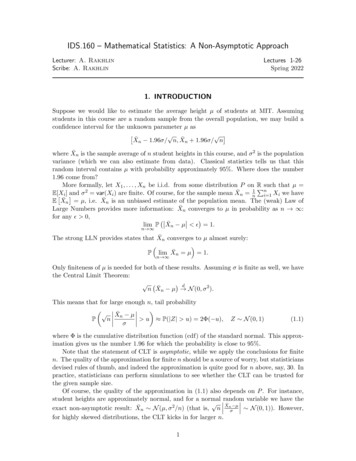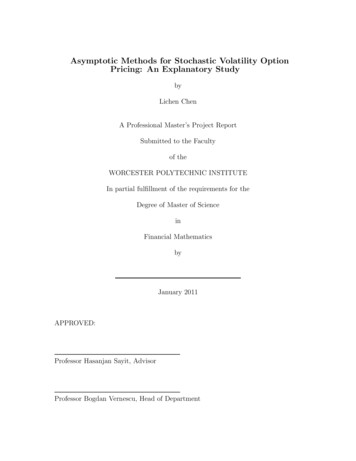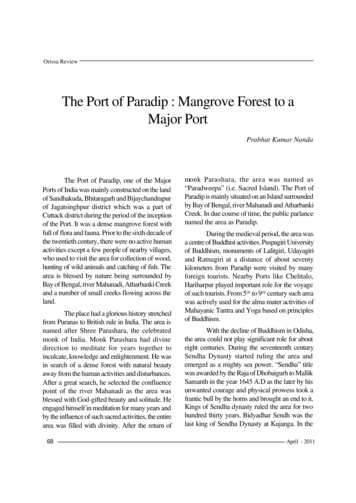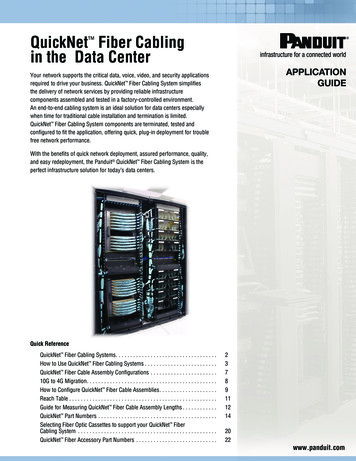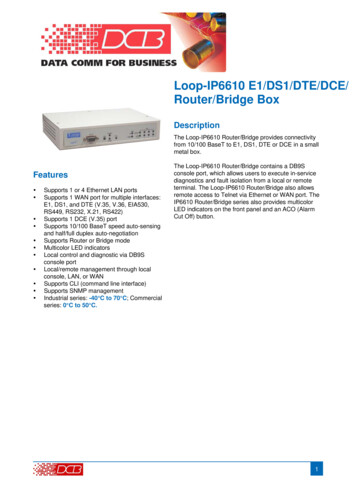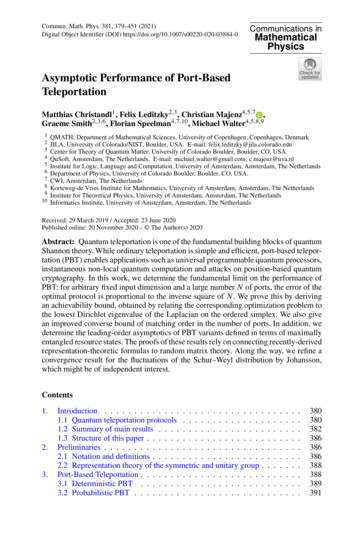
Transcription
Commun. Math. Phys. 381, 379–451 (2021)Digital Object Identifier (DOI) ations inMathematicalPhysicsAsymptotic Performance of Port-BasedTeleportationMatthias Christandl1 , Felix Leditzky2,3 , Christian Majenz4,5,7 ,Graeme Smith2,3,6 , Florian Speelman4,7,10 , Michael Walter4,5,8,912345678910QMATH, Department of Mathematical Sciences, University of Copenhagen, Copenhagen, DenmarkJILA, University of Colorado/NIST, Boulder, USA. E-mail: felix.leditzky@jila.colorado.eduCenter for Theory of Quantum Matter, University of Colorado Boulder, Boulder, CO, USAQuSoft, Amsterdam, The Netherlands. E-mail: michael.walter@gmail.com; c.majenz@uva.nlInstitute for Logic, Language and Computation, University of Amsterdam, Amsterdam, The NetherlandsDepartment of Physics, University of Colorado Boulder, Boulder, CO, USA.CWI, Amsterdam, The NetherlandsKorteweg-de Vries Institute for Mathematics, University of Amsterdam, Amsterdam, The NetherlandsInstitute for Theoretical Physics, University of Amsterdam, Amsterdam, The NetherlandsInformatics Institute, University of Amsterdam, Amsterdam, The NetherlandsReceived: 29 March 2019 / Accepted: 23 June 2020Published online: 20 November 2020 – The Author(s) 2020Abstract: Quantum teleportation is one of the fundamental building blocks of quantumShannon theory. While ordinary teleportation is simple and efficient, port-based teleportation (PBT) enables applications such as universal programmable quantum processors,instantaneous non-local quantum computation and attacks on position-based quantumcryptography. In this work, we determine the fundamental limit on the performance ofPBT: for arbitrary fixed input dimension and a large number N of ports, the error of theoptimal protocol is proportional to the inverse square of N . We prove this by derivingan achievability bound, obtained by relating the corresponding optimization problem tothe lowest Dirichlet eigenvalue of the Laplacian on the ordered simplex. We also givean improved converse bound of matching order in the number of ports. In addition, wedetermine the leading-order asymptotics of PBT variants defined in terms of maximallyentangled resource states. The proofs of these results rely on connecting recently-derivedrepresentation-theoretic formulas to random matrix theory. Along the way, we refine aconvergence result for the fluctuations of the Schur–Weyl distribution by Johansson,which might be of independent interest.Contents1.2.3.Introduction . . . . . . . . . . . . . . . . . . . . . . . . . .1.1 Quantum teleportation protocols . . . . . . . . . . . . .1.2 Summary of main results . . . . . . . . . . . . . . . . .1.3 Structure of this paper . . . . . . . . . . . . . . . . . . .Preliminaries . . . . . . . . . . . . . . . . . . . . . . . . . .2.1 Notation and definitions . . . . . . . . . . . . . . . . . .2.2 Representation theory of the symmetric and unitary groupPort-Based Teleportation . . . . . . . . . . . . . . . . . . . .3.1 Deterministic PBT . . . . . . . . . . . . . . . . . . . .3.2 Probabilistic PBT . . . . . . . . . . . . . . . . . . . . .380380382386386386388388389391
380M. Christandl, F. Leditzky, C. Majenz, G. Smith, F. Speelman, M. Walter3.3 Symmetries . . . . . . . . . . . . . . . . . . . .3.4 Representation-theoretic characterization . . . . .4. The Schur–Weyl Distribution . . . . . . . . . . . . .5. Probabilistic PBT . . . . . . . . . . . . . . . . . . .6. Deterministic PBT . . . . . . . . . . . . . . . . . . .6.1 Asymptotics of the standard protocol . . . . . . .6.2 Asymptotics of the optimal protocol . . . . . . .7. Converse Bound . . . . . . . . . . . . . . . . . . . .8. Conclusion . . . . . . . . . . . . . . . . . . . . . . .A. Proof of Lemma 3.6 . . . . . . . . . . . . . . . . . .B. A Family of Explicit Protocols for Deterministic PBTC. The Maximal Eigenvalue of a 2 2 GUE0 Matrix . .D. Technical Lemmas . . . . . . . . . . . . . . . . . . .3923953974064084094214324374394414454461. Introduction1.1. Quantum teleportation protocols. Quantum teleportation [1] is a fundamental quantum information-processing task, and one of the hallmark features of quantum information theory: Two parties Alice and Bob may use a shared entangled quantum statetogether with classical communication to “teleport” an unknown quantum state fromAlice to Bob. The original protocol in [1] consists of Alice measuring the unknownstate together with her half of the shared entangled state and letting Bob know about theoutcome of her measurement. Based on this information Bob can then manipulate hishalf of the shared state by applying a suitable correction operation, thus recovering theunknown state in his lab.From an information-theoretic point of view, quantum teleportation implements aquantum channel between Alice and Bob. If the shared entangled state is a noiseless, maximally entangled state (a so-called EPR state, named after a famous paper byEinstein, Podolski, and Rosen [2]), then this quantum channel is in fact a perfect, noiseless channel. On the other hand, using a noisy entangled state as the shared resource inthe teleportation protocol renders the effective quantum channel imperfect or noisy. Acommon way to measure the noise in a quantum channel is by means of the entanglementfidelity, which quantifies how well the channel preserves generic correlations with aninaccessible environment system (see Sect. 2.1 for a definition).Port-based teleportation (PBT) [3,4] is a variant of the original quantum teleportation protocol [1], where the receiver’s correction operation consists of merely pickingthe right subsystem, called port, of their part of the entangled resource state. Figure 1provides a schematic description of the protocol (see Sect. 3 for a more detailed explanation). While being far less efficient than the ordinary teleportation protocol, the simplecorrection operation allows the receiver to apply a quantum operation to the output ofthe protocol before receiving the classical message. This simultaneous unitary covariance property enables all known applications that require PBT instead of just ordinaryquantum teleportation, including the construction of universal programmable quantumprocessors [3], quantum channel discrimination [5] and instantaneous non-local quantumcomputation (INQC) [6].In the INQC protocol, which was devised by Beigi and König [6], two spatially separated parties share an input state and wish to perform a joint unitary on it. To do so,they are only allowed a single simultaneous round of communication. INQC provides ageneric attack on any quantum position-verification scheme [7], a protocol in the field of
Asymptotic Performance of Port-Based t number iFig. 1. Schematic representation of port-based teleportation (PBT). Like in ordinary teleportation, the senderapplies a joint measurement to her input system A and her parts of the entangled resource, Ai , i 1, . . . , N ,and sends the outcome to the receiver, who applies a correction operation. In PBT, however, this correctionoperation merely consists of choosing one of the subsystems Bi , the ports, of the entangled resource. A PBTprotocol cannot implement a perfect quantum channel with a finite number of ports. There are different variantsof PBT. The four commonly studied ones are characterized by whether failures are announced, or heralded(probabilistic PBT) or go unnoticed (deterministic PBT), and whether simplifying constraints on the resourcestate and the sender’s measurement are enforcedposition-based cryptography [6,8–10]. It is therefore of great interest for cryptographyto characterize the resource requirements of INQC: it is still open whether a computationally secure quantum position-verification scheme exists, as all known generic attacksrequire an exponential amount of entanglement. Efficient protocols for INQC are onlyknown for special cases [11–14]. The best lower bounds for the entanglement requirements of INQC are, however, linear in the input size [6,15,16], making the hardnessof PBT, the corner stone of the best known protocol, the only indication for a possiblehardness of INQC.PBT comes in two variants, deterministic and probabilistic, the latter being distinguished from the former by the fact that the protocol implements a perfect quantumchannel whenever it does not fail (errors are “heralded”). In addition, two classes of protocols have been considered in the literature, one using maximally entangled resourcestates and the other using more complex resources optimized for the protocol. The appeal of the former type of protocol is mostly due to the fact that maximally entangledstates are a standard resource in quantum information processing and can be preparedefficiently. Using a protocol based on maximally entangled resources thus removes oneparameter from the total complexity of the protocol, the complexity of preparing theresource, leaving the amount of resources as well as the complexity of the involvedquantum measurement as the remaining two complexity contributions.In their seminal work [3,4], Ishizaka and Hiroshima completely characterize the problem of PBT for qubits. They calculate the performance of the standard1 and optimizedprotocols for deterministic and the EPR and optimized protocols for probabilistic PBT,and prove the optimality of the ‘pretty good’ measurement in the standard deterministiccase. They also show a lower bound on the performance of the standard protocol for1 The standard protocol uses a maximally entangled resource state and the so-called Pretty Good Measurement.
382M. Christandl, F. Leditzky, C. Majenz, G. Smith, F. Speelman, M. Walterdeterministic PBT, which was later reproven in [6]. Further properties of PBT were explored in [17], in particular with respect to recycling part of the resource state. Conversebounds for the probabilistic and deterministic versions of PBT have been proven in [18]and [19], respectively. In [20], exact formulas for the fidelity of the standard protocol fordeterministic PBT with N 3 or 4 in arbitrary dimension are derived using a graphicalalgebra approach. Recently, exact formulas for arbitrary input dimension in terms ofrepresentation-theoretic data have been found for all four protocols, and the asymptoticsof the optimized probabilistic case have been derived [21,22].Note that, in contrast to ordinary teleportation, a protocol obtained from executingseveral PBT protocols is not again a PBT protocol. This is due to the fact that the wholeinput system has to be teleported to the same output port for the protocol to have thementioned simultaneous unitary covariance property. Therefore, the characterization ofprotocols for any dimension d is of particular interest. The mentioned representationtheoretic formulas derived in [21,22] provide such a characterization. It is, however, notknown how to evaluate these formulas efficiently for large input dimension.1.2. Summary of main results. In this paper we provide several characterization resultsfor port-based teleportation. As our main contributions, we characterize the leadingorder asymptotic performance of fully optimized deterministic port-based teleportation(PBT), as well as the standard protocol for deterministic PBT and the EPR protocol forprobabilistic PBT. In the following, we provide a detailed summary of our results. Theseresults concern asymptotic characterizations of the entanglement fidelity of deterministicPBT, defined in Sect. 3.1, and the success probability of probabilistic PBT, defined inSect. 3.2.Our first, and most fundamental, result concerns deterministic PBT and characterizesthe leading-order asymptotics of the optimal fidelity for a large number of ports.Theorem 1.1. For arbitrary but fixed local dimension d, the optimal entanglementfidelity for deterministic port-based teleportation behaves asymptotically asFd (N ) 1 (N 2 ).Theorem 1.1 is a direct consequence of Theorem 1.5 below. Prior to our work, it was onlyknown that Fd (N ) 1 (N 2 ) as a consequence of an explicit converse bound [19].We prove that this asymptotic scaling is in fact achievable, and we also provide a conversewith improved dependency on the local dimension, see Corollary 1.6.For deterministic port-based teleportation using a maximally entangled resource andthe pretty good measurement, a closed expression for the entanglement fidelity wasderived in [21], but its asymptotics for fixed d 2 and large N remained undetermined.As our second result, we derive the asymptotics of deterministic port-based teleportationusing a maximally entangled resource and the pretty good measurement, which we callthe standard protocol.Theorem 1.2. For arbitrary but fixed d and any δ 0, the entanglement fidelity of thestandard protocol of PBT is given byFdstd (N ) 1 3d2 1 O(N 2 δ ).4N
Asymptotic Performance of Port-Based Teleportation383d 3d 2110.950.980.90.960.85Fdstd (N )2 11 d4N0.940.92050100N1500.80.75200050d 4150200150200d NFig. 2. Entanglement fidelity of the standard protocol for deterministic port-based teleportation in local dimension d 2, 3, 4, 5 using N ports [23]. We compare the exact formula (3.5) for Fdstd (blue dots) with thefirst-order asymptotics obtained from Theorem 1.2 (orange curve)Previously, the asymptotic behavior given in the above theorem was only known for d std2 in termsan exact formula for finite N ; for d 2, it was merely known that Fd (N ) of 1[4]. In Fig. 2 we compare the asymptotic formula of Theorem 1.2 to a1 O Nnumerical evaluation of the exact formula derived in [21] for d 5.For probabilistic port-based teleportation, Mozrzymas et al. [22] obtained the following expression for the success probability pd optimized over arbitrary entangledresources:pd (N ) 1 d2 1,d2 1 Nvalid for all values of d and N (see the detailed discussion in Sect. 3). In the case ofusing N maximally entangled states as the entangled resource, an exact expression forthe success probability in terms of representation-theoretic quantities was also derivedin [21]. We state this expression in (3.9) in Sect. 3. However, its asymptotics for fixedd 2 and large N have remained undetermined to date. As our third result, we derivethe following expression for the asymptotics of the success probability of the optimalprotocol among the ones that use a maximally entangled resource, which we call theEPR protocol.
384M. Christandl, F. Leditzky, C. Majenz, G. Smith, F. Speelman, M. Walterd 3, c3 1.90414d 2, c2 1.12838110.80.80.60.60.4pEPR(N )d 1 cd d/(N 1)01002003004000.25000200300400d 4, c4 2.52811d 5, c5 N40050000100200N300500400Fig. 3. Success probability of the EPR protocol for probabilistic port-based teleporation in local dimensiond 2, 3, 4, 5 using N ports [23]. We compare the exact formula (3.9) for pdEPR (blue dots) with the first-orderasymptotic formula obtained from Theorem 1.3 (orange curve). The first-order coefficient cd E[λmax (G)]appearing in the formula in Theorem 1.3 was obtained by numerical integration from the eigenvalue distributionof GUEdTheorem 1.3. For probabilistic port-based teleportation in arbitrary but fixed dimensiond with EPR pairs as resource states, dEPRE[λmax (G)] o N 1/2 ,pd (N ) 1 N 1where G GUE0d .The famous Wigner semicircle law [24] provides an asymptotic expression for the expected maximal eigenvalue, E[λmax (G)] 2 d for d . Additionally, there existexplicit upper and lower bounds for all d, see the discussion in Sect. 5.To establish Theorems 1.2 and 1.3, we analyze the asymptotics of the Schur–Weyldistribution, which also features in other fundamental problems of quantum informationtheory including spectrum estimation, tomography, and the quantum marginal problem [25–35]. Our main technical contribution is a new convergence result for its fluctuations that strengthens a previous result by Johansson [36]. This result, which may beof independent interest, is stated as Theorem 4.1 in Sect. 4.
Asymptotic Performance of Port-Based Teleportation385Theorem 1.1 is proved by giving an asymptotic lower bound for the optimal fidelityof deterministic PBT, as well as an upper bound that is valid for any number of ports andmatches the lower bound asymptotically. For the lower bound, we again use an expressionfor the entanglement fidelity of the optimal deterministic PBT protocol derived in [22].The asymptotics of this formula for fixed d and large N have remained undeterminedso far. We prove an asymptotic lower bound for this entanglement fidelity in terms ofthe lowest Dirichlet eigenvalue of the Laplacian on the ordered (d 1)-dimensionalsimplex.Theorem 1.4. The optimal fidelity for deterministic port-based teleportation is boundedfrom below byFd (N ) 1 where OSd 1 x Rd λ1 (OSd 1 ) O(N 3 ),dN2ixi 1, xi xi 1 , xd 0is the (d 1)-dimensional simplex of ordered probability distributions with d outcomesand λ1 ( ) is the first eigenvalue of the Dirichlet Laplacian on a domain .Using a bound from [37] for λ1 (OSd ), we obtain the following explicit lower bound.Theorem 1.5. For the optimal fidelity of port-based teleportation with arbitrary but fixedinput dimension d and N ports, the following bound holds,Fd (N ) 1 d 5 O(d 9/2 ) O(N 3 ). 4 2N 2As a complementary result, we give a strong upper bound for the entanglement fidelityof any deterministic port-based teleportation protocol. While valid for any finite numberN of ports, its asymptotics for large N are given by 1 O(N 2 ), matching Theorem 1.5.Corollary 1.6. For a general port-based teleportation scheme with input dimension dand N ports, the entanglement fidelity Fd and the diamond norm error εd can be boundedas 22N2 1 dNif N d2if N d2 dFd (N ) ε(N) 22d 1 11 d16Notherwise2 d16Notherwise.22Previously, the best known upper bound on the fidelity [19] had the same dependenceon N , but was increasing in d, thus failing to reflect the fact that the task becomes harderwith increasing d. Interestingly, a lower bound from [38] on the program register sizeof a universal programmable quantum processor also yields a converse bound for PBTthat is incomparable to the one from [19] and weaker than our bound.Finally we provide a proof of the following ‘folklore’ fact that had been used inprevious works on port-based teleportation. The unitary and permutation symmetries ofport-based teleportation imply that the entangled resource state and Alice’s measurementcan be chosen to have these symmetries as well. Apart from simplifying the optimization over resource states and POVMs, this implies that characterizing the entanglementfidelity is sufficient to give worst-case error guarantees. Importantly, this retrospectively
386M. Christandl, F. Leditzky, C. Majenz, G. Smith, F. Speelman, M. Walterjustifies the use of the entanglement fidelity F in the literature about deterministic portbased teleportation in the sense that any bound on F implies a bound on the diamondnorm error without losing dimension factors. This is also used to show the diamondnorm statement of Corollary 1.6.Proposition 1.7 (Proposition 3.4 and 3.3 and Corollary 3.5, informal). There is an explicit transformation between port-based teleportation protocols that preserves any unitarily invariant distance measure on quantum channels, and maps an arbitrary portbased teleportation protocol with input dimension d and N ports to a protocol that(i) has a resource state and a POVM with U (d) S N symmetry, and(ii) implements a unitarily covariant channel.In particular, the transformation maps an arbitrary port-based teleportation protocol toone with the symmetries (i) and (ii) above, and entanglement fidelity no worse than theoriginal protocol. Point (ii) implies that εd 2 1 Fd ,where Fd and εd denote the optimal entanglement fidelity and optimal diamond normerror for deterministic port-based teleportation.1.3. Structure of this paper. In Sect. 2 we fix our notation and conventions and recallsome basic facts about the representation theory of the symmetric and unitary groups. InSect. 3 we define the task of port-based teleportation (PBT) in its two main variants, theprobabilistic and deterministic setting. Moreover, we identify the inherent symmetriesof PBT, and describe a representation-theoretic characterization of the task. In Sect. 4 wediscuss the Schur–Weyl distribution and prove a convergence result that will be neededto establish our results for PBT with maximally entangled resources. Our first main resultis proved in Sect. 5, where we discuss the probabilistic setting in arbitrary dimensionusing EPR pairs as ports, and determine the asymptotics of the success probability pdEPR(Theorem 1.3). Our second main result, derived in Sect. 6.1, concerns the deterministicsetting in arbitrary dimension using EPR pairs, for which we compute the asymptoticsof the optimal entanglement fidelity Fdstd (Theorem 1.2). Our third result, an asymptoticlower bound on the entanglement fidelity Fd of the optimal protocol in the deterministicsetting (Theorem 1.5), is proved in Sect. 6.2. Finally, in Sect. 7 we derive a general nonasymptotic converse bound on deterministic port-based teleportation protocols using anon-signaling argument (Theorem 7.5). We also present a lower bound on the communication requirements for approximate quantum teleportation (Corollary 7.4). We makesome concluding remarks in Sect. 8. The appendices contain technical proofs.2. Preliminaries2.1. Notation and definitions. We denote by A, B, quantum systems with associatedHilbert spaces H A , H B , , which we always take to be finite-dimensional, and weassociate to a multipartite quantum system A1 . . . An the Hilbert space H A1 .An H A1 . . . H An . When the Ai are identical, we also write An A1 . . . An . The set oflinear operators on a Hilbert space H is denoted by B(H). A quantum state ρ A onquantum system A is a positive semidefinite linear operator ρ A B(H A ) with unittrace, i.e., ρ A 0 and tr(ρ A ) 1. We denote by I A or 1 A the identity operator on
Asymptotic Performance of Port-Based Teleportation387H A , and by τ A I A / A the corresponding maximally mixed quantum state, where A : dim H A . A pure quantum state ψ A is a quantum state of rank one. We can writeψ A ψ ψ A for a unit vector ψ A H A . For quantum systems A, A of dimensiondd , the vector φ dim H A dim H A d with bases { i A }i 1and { i A }i 1AAd1 i A defines the maximally entangled state of Schmidt rank d. The iAi 1d fidelity F(ρ, σ ) between two quantum states is defined by F(ρ, σ ) : ρ σ 21 , where X 1 tr( X † X ) denotes the trace norm of an operator. For two pure states ψ and φ , the fidelity is equal to F(ψ, φ) ψ φ 2 . A quantum channel is a completelypositive, trace-preserving linear map : B(H A ) B(H B ). We also use the notation: A B or A B , and we denote by id A the identity channel on A. Given twoquantum channels 1 , 2 : A B, the entanglement fidelity F( 1 , 2 ) is defined asF(1,2 ) : F((id A 1 )(φ A A ), (id A 2 )(φ A A )),and we abbreviate F( ) : F( , id). The diamond norm of a linear mapB(H B ) is defined by : sup X A A 1 1: B(H A ) (id A )(X A A ) 1 .The induced distance on quantum channels is called the diamond distance. A positiveoperator-valued measure (POVM) E {E x } on a quantum system A is a collection ofpositive semidefinite operators E x 0 satisfying x E x I A .We denote random variables by bold letters (X, Y, Z, ) and the valued they take bythe non-bold versions (X, Y, Z , . . .). We denote by X P that X is a random variablewith probability distribution P. We write Pr(. . .) for the probability of an event andPE [. . .] for expectation values. The notation Xn X (n ) denotes convergence inDprobability and Xn X (n ) denotes convergence in distribution. The latter can bedefined, e.g., by demanding that E [ f (Xn )] E [ f (X)] (n ) for every continuous,bounded function f . The Gaussian unitary ensemble GUEd is the probability distributionon the set of Hermitian d d-matrices H with density Z d 1 exp( 21 tr H 2 ), where Z dis the appropriate normalization constant. Alternatively, for X GUEd , the entries Xiifor 1 i d are independently distributed as Xii N (0, 1), whereas the elementsXi j for 1 i j d are independently distributed as Xi j N (0, 21 ) i N (0, 21 ).Here, N (0, σ 2 ) denotes the centered normal distribution with variance σ 2 . The tracelessGaussian unitary ensemble GUE0d can be defined as the distribution of the randomvariable Y : X trdX I , where X GUEd .For a complex number z C, we denote by (z) and (z) its real and imaginarypart, respectively. We denote by μ d n a partition (μ1 , . . . , μd ) of n into d parts. Thatis, μ Zd with μ1 μ2 · · · μd 0 and i μi n. We also call μ a Youngdiagram and visualize it as an arrangement of boxes, with μi boxes in the ith row. Forexample, μ (3, 1) can be visualized as. We use the notation (i, j) μ to meanthat (i, j) is a box in the Young diagram μ, that is, 1 i d and 1 j μi . Wedenote by GL(H) the general linear group and by U (H) the unitary group acting on aHilbert space H. When H Cd , we write GL(d) and U (d). Furthermore, we denote bySn the symmetric group on n symbols. A representation ϕ of a group G on a vector spaceH is a map G g ϕ(g) GL(H) satisfying ϕ(gh) ϕ(g)ϕ(h) for all g, h G.In this paper all representations are unitary, which means that H is a Hilbert space andϕ(g) U (H) for every g G. A representation is irreducible (or an irrep) if H containsno nontrivial invariant subspace.
388M. Christandl, F. Leditzky, C. Majenz, G. Smith, F. Speelman, M. Walter2.2. Representation theory of the symmetric and unitary group. Our results rely on therepresentation theory of the symmetric and unitary groups and Schur–Weyl duality (aswell as their semiclassical asymptotics which we discuss in Sect. 4). In this section weintroduce the relevant concepts and results (see e.g., [39,40].The irreducible representations of Sn are known as Specht modules and labeled byYoung diagrams with n boxes. We denote the Specht module of Sn corresponding to aYoung diagram μ d n by [μ] (d is arbitrary). Its dimension is given by the hook lengthformula [39, pp. 53–54],n!,(i, j) μ h μ (i, j)dμ (2.1)where h μ (i, j) is the hook length of the hook with corner at the box (i, j), i.e., thenumber of boxes below (i, j) plus the number of boxes to the right of (i, j) plus one(the box itself).The polynomial irreducible representations of U (d) are known as Weyl modules andlabeled by Young diagrams with no more than d rows. We denote the Weyl moduleof U (d) corresponding to a Young diagram μ d n by Vμd (n is arbitrary). Its dimensioncan be computed using Stanley’s hook length formula [39, p. 55],m d,μ d c(i, j),h μ (i, j)(2.2)(i, j) μwhere c(i, j) j i is the so-called content of the box (i, j). This is an alternative tothe Weyl dimension formula, which states thatm d,μ 1 i j dμi μ j j i.j i(2.3)We stress that m d,μ depends on the dimension d. ngiven by permuting theConsider the representations of Sn and U (d) on Cdtensor factors, and multiplication by U n , respectively. Clearly the two actions commute. ninto irreps takes the formSchur–Weyl duality asserts that the decomposition of Cd(see, e.g., [40]) n Cd[μ] Vμd .(2.4) μ d n3. Port-Based TeleportationThe original quantum teleportation protocol for qubits (henceforth referred to as ordinaryteleportation protocol) is broadly described as follows [1]: Alice (the sender) and Bob(the receiver) share an EPR pair (a maximally entangled state on two qubits), and theirgoal is to transfer or ‘teleport’ another qubit in Alice’s possession to Bob by sendingonly classical information. Alice first performs a joint Bell measurement on the quantumsystem to be teleported and her share of the EPR pair, and communicates the classicalmeasurement outcome to Bob using two bits of classical communication. Conditionedon this classical message, Bob then executes a correction operation consisting of oneof the Pauli operators on his share of the EPR pair. After the correction operation, he
Asymptotic Performance of Port-Based Teleportation389has successfully received Alice’s state. The ordinary teleportation protocol can readilybe generalized to qudits, i.e., d-dimensional quantum systems. Note that while the term‘EPR pair’ is usually reserved for a maximally entangled state on two qubits (d 2),we use the term more freely for maximally entangled states of Schmidt rank d on twoqudits, as defined in Sect. 2.Port-based teleportation, introduced by Ishizaka and Hiroshima [3,4], is a variant ofquantum teleportation where Bob’s correction operation solely consists of picking oneof a number of quantum subsystems upon receiving the classical message from Alice. Inmore detail, Alice and Bob initially share an entangled resource quantum state ψ A N B N ,where H Ai H Bi Cd for i 1, . . . , N . We may always assume that the resourcestate is pure, for we can give a purification to Alice and she can choose not to use it.2Bob’s quantum systems Bi are called ports. Just like in ordinary teleportation, the goal isfor Alice to teleport a d-dimensional quantum system A0 to Bob. To achieve this, AliceN on the input and her part of the resource state andperforms a joint POVM {(E i ) A0 A N }i 1sends the outcome i to Bob. Based on the index i he receives, Bob selects the ith po
E-mail: felix.leditzky@jila.colorado.edu 3 Center for Theory of Quantum Matter, University of Colorado Boulder, Boulder, CO, USA 4 QuSoft, Amsterdam, The Netherlands. E-mail: michael.walter@gmail.com; c.majenz@uva.nl 5 Institute for Logic, Language and Computation, University of Amsterdam, Amsterdam, The Netherlands
